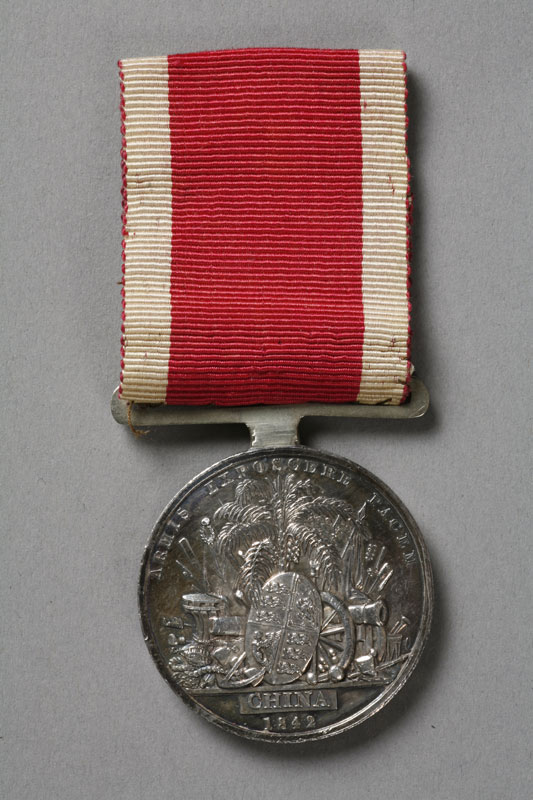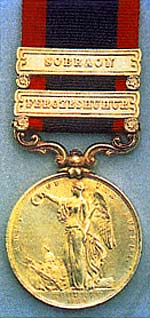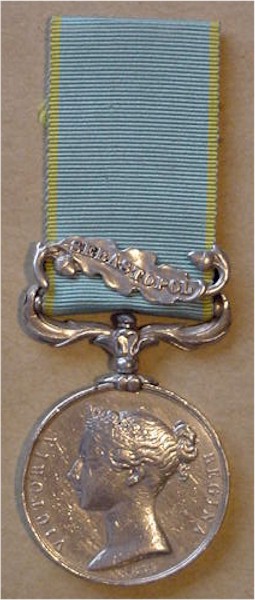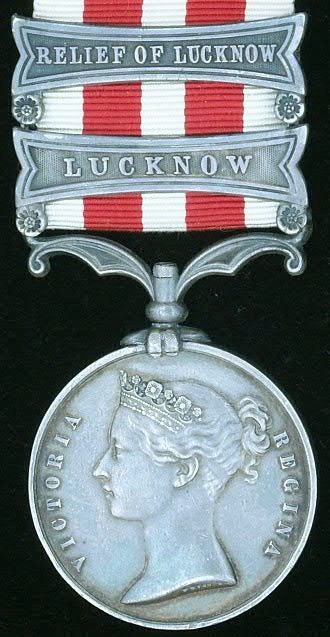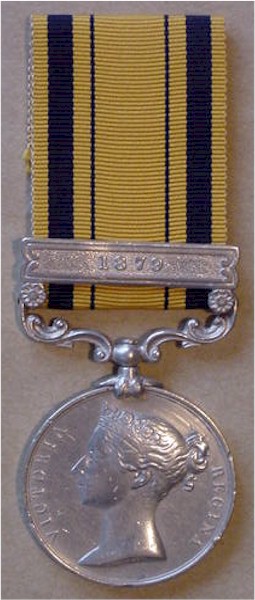British Victorian Campaign Medals, 1839 to 1880
For Campaigns in India, Afghanistan, Africa, etc.
By Stephen Sherman, Dec. 2008. Updated July 20, 2011.
During the first four decades of Queen Victoria's long reign, the British Empire waged campaigns in India, Afghanistan, the Crimea, China, South Africa, and other areas. The famed Victoria Cross was (and still is) cast from bronze from a captured Russian cannon during the Crimean War.
The campaigns in Afghanistan alone produced six medals and stars: Ghuznee 1839, Jellalabad 1841-42, Defence of Kelat-I-Ghilzie 1842; Candahar, Cabul and Ghuznee 1842-43; Afghanistan 1878-80, and the Kabul to Khandahar Star 1880.
The Indian campaigns created five: Gwalior Campaign Stars 1843, Scinde Campaign 1843, Sutlej Campaign 1845-46, Punjab Campaign 1848-49, and the Indian Mutiny 1857-59. As an aside, the Scinde Campaign medal does not include the famous pun message "Peccavi," sent by the victorious British general Sir Charles Napier, i.e. Latin for "I have sinned."
Other campaign and service medals were issued for the: First China War 1840-42, New Zealand 1845-47 and 1860-66, Baltic 1854-55, Crimean War 1854-56, Turkish Crimean War 1854-56,Second China War 1857-60, Canada General Service 1866-70, Abyssinian War 1867-68, Ashantee War 1873-74, and South Africa Service 1877-79.
Many of the places are spelled differently today, e.g. Sindh for Scinde, and Jalalabad for Jellalabad, but the descriptions here represent the contemporary spellings used on the original medals. These medals and stars are described here, in chronological order.
GHUNZEE MEDAL 1839
Description: (shown upper left)
This medal was struck on orders by the Shah of Afghanistan in 1839 to show his appreciation to the British forces that had restored him to his throne. The obverse shows the fortress of Ghunzee with the word 'GHUNZEE' below. On the reverse can be seen a mural crown surrounded by a laurel wreath with the date '23 JULY' above and '1839' in the exergue below. The suspender is straight with a ring passing through a smaller loop sweated to the top of the medal.
Clasps:
None authorised for this medal.
Ribbon:
The ribbon measures 1.46" wide with two equal stripes of crimson and green. The original ribbon was intended to be green and yellow.
Naming:
This medal was issued unnamed but many were named in the field in various styles.
Notes:
Two separate dies exist for this medal with one having a wider border around the edge than the other which itself has a narrower and taller fortress.
FIRST CHINA WAR MEDAL 1840-42
Description:
The obverse of this medal depicts the familiar head of young Queen Victoria with the legend 'VICTORIA REGINA'. The reverse has a trophy of arms with an oval shield to the centre bearing the Royal Arms underneath a palm tree. Above this is the legend 'ARMIS EXPOSCERE PACEM' and the word 'CHINA' with the date 1842 in the exergue below. The non-swivelling suspender is plain and straight being sweated directly to the medal.
Clasps:
Non authorised for this medal.
Ribbon:
1.50" wide of crimson with yellow edges.
Naming:
Bold block capital letters with stars used to fill in the spaces as per the Waterloo Medal.
Notes:
The reverse of this medal was originally designed depicting the British lion devouring a Chinese dragon. However it considered too insensitive to the Chinese and so the reverse described above was used for this and the subsequent 2nd and 3rd China War medals.
JELLALABAD MEDAL 1841-42
Description:
There are two issues of this medal of different designs. The first issue has the 'Mural Crown' with the inscription 'JELLALABAD' above on the obverse while the reverse has the date 'VII APRIL 1842'. The suspender is of a straight steel design which was either fixed directly to the medal or by a small ring. The second design has the head of young Queen Victoria with the legend 'VICTORIA VINDEX' or 'VICTORIA REGINA' while the reverse had the winged figure of Victory with a laurel wreath in her right hand and the Union Jack in her left. The upper half of the reverse also bears the inscription 'JELLALABAD VII APRIL' while the date 'MDCCCXLII' appears in the exergue below.
Clasps:
Non authorised for this medal.
Ribbon:
1.75" wide of the Indian watered rainbow pattern with the red edge to the left and a blue edge to the right with a wide central yellow stripe.
Naming:
Indented block letters.
Notes:
The second version was introduced after it became apparent that there was not enough medals produced to cover all those who were entitled to one. It was also felt by the Governor General of India that the first issue was too crude and so a redesign was made by W. Wyon. Of the second issue very few medals were struck with the legend 'VICTORIA REGINA' and so are more collectable.
DEFENCE OF KELAT-I-GHILZIE MEDAL 1842
Description:
The obverse of this medal is a laurel wreath with the 'Mural Crown' at the top within which is a shield with the inscription 'KELAT-I-GHILZIE'. The reverse has a trophy of arms on top of a plaque bearing the inscription 'INVICTA MDCCCXLII'. The suspender is straight attached via a pin which passes through a steel clip attached to the top of the medal.
Clasps:
Non authorised for this medal.
Ribbon:
1.75" wide of the Indian watered rainbow pattern with the red edge to the left and a blue edge to the right with a wide central yellow stripe.
Naming:
Engraved in script.
Notes:
None.
CANDAHAR, CABUL & GHUZNEE MEDALS 1842-43
Description:
As with most early Victorian medals this award bears the young head of Queen Victoria and the legend 'VICTORIA REGINA' on its obverse. The reverse of this medal can differ depending on which action(s) it was awarded with four variants encountered including: 1) 'CANDAHAR' with the date '1842' within a laurel wreath underneath a the royal crown; 2) identical but with 'CABUL' within the wreath; 3) a pair of intertwined laurel wreaths with 'GHUZNEE' and 'CABUL' inside and the date 1842 in the exergue below; 4) same as 1 and 2 above but with ' CANDAHAR', 'GHUZNEE' and 'CABUL' within the wreath. The suspender is wide enough to take the 1.75" ribbon and is attached to the medal by a steel clip.
Clasps:
None authorised for this medal.
Ribbon:
1.75" wide and of a rainbow (watered) pattern with a central yellow stripe flanked by white and a red edge to the left and blue to the right.
Naming:
Naming is usually encountered with running script, indented capitals or even unnamed.
Notes:
A very rare version of the 'CABUL' medal exists with the spelling 'CABVL' to the reverse.
SCINDE CAMPAIGN MEDALS 1843
Description:
There are three versions of this medal for the various actions fought during the Scinde campaign. The obverse is common to all issues with the head of the young Queen Victoria and the legend 'VICTORIA REGINA'. The reverse of the first strike has the Royal Crown of Queen Victoria at the top and a laurel wreath which contains the inscription 'MEEANEE 1843'. The second strike is identical but with the inscription 'HYDERABAD 1843' within the wreath while the third strike has 'MEEANEE, HYDERABAD 1843'. The suspender is of the common swivelling ornate scroll type encountered on many Victorian medals and is sweated to the medal.
Clasps:
Non authorised for this medal.
Ribbon:
1.75" wide of the Indian watered rainbow pattern with the red edge to the left and a blue edge to the right with a wide central yellow stripe. The ribbon is far too wide for the suspender designed to take a 1.25" ribbon.
Naming:
Either block capital letters or engraved in script.
Notes:
The first strike of this medal bearing the 'MEEANEE 1843' reverse is very rare with only 65 being issued to the 22nd Foot, the remainder being awarded to native troops.
SUTLEJ CAMPAIGN MEDAL 1845-46
British and Indian soldiers who took part in the First Sikh War received the medal entitled "Sutlej Campaign, 1845-6".
Description:
Obverse.-Crowned head of Queen Victoria. Legend: "Victoria Regina." Reverse.-Victory standing beside a trophy, holding a wreath in her outstretched hand. Inscription: "Army of the Sutlej."
Clasps:
Where a soldier took part in one or more battles, his medal would have the first battle inscribed on the reverse side of the medal and the remaining battles on clasps on the ribbon. The battles being described as: "Moodkee 1845", "Ferozeshuhur 1845", "Aliwal 1946" and "Sobraon 1846".
Ribbon:
Dark blue with crimson edges. 1¼ inches wide.
Mounting.-Silver scroll bar and swivel.
PUNJAB CAMPAIGN MEDAL 1848-49
Description:
The obverse bears the diademed head of young Queen Victoria and the legend 'VICTORIA REGINA'. The reverse depicts the Sikh army surrendering to Major General Sir Walter Gilbert while in the background can be seen troops of the East India Company and the inscription 'ARMY OF THE PUNJAB' above with the date 'MDCCCXLIX' in the exergue below. The suspender is of an ornate scroll type sweated to the medal.
Clasps:
'MOOLTAN', 'CHILIANWALA' and 'GOOJERAT'.
Ribbon:
Dark blue with yellow borders and 1.25" wide.
Naming:
Impressed in Roman capitals for European troops and in running script or uneven capitals for native troops.
Notes:
Only a maximum of two clasps could be awarded to any recipient.
NEW ZEALAND MEDAL 1845-47 & 1860-66
Description:
The obverse depicts Queen Victoria's diademed head with a veil at the rear and the legend 'VICTORIA D: G: BRITT: REG: F: D:'. The reverse has a laurel wreath with the appropriate dates for one of the many campaigns in New Zealand and the inscriptions 'NEW ZEALAND' above and 'VIRTUTIS HONOR' below. The swivelling suspender is unique to this medal being of an unusual foliated design.
Clasps:
No clasps were authorised for this medal.
Ribbon:
The 1.25" wide ribbon is dark blue with a central red stripe .375" wide.
Naming:
Naming is usually done with impressed Roman capitals to both army and navy while engraving is seen on those awarded to local militia units.
Notes:
Collectors find medals awarded to those who fought in the battle of Gate Pah as highly collectable.
BALTIC MEDAL 1854-55
History:
Instituted April 1856 for award to those that served with the Naval deployment to the Baltic during the Crimean war. This is mainly a Royal Navy and Royal Marines medal although 106 medals were issued to a Royal Engineer contingent present.
Description:
Sanctioned in April 1856 the obverse of this medal shows the diademed head of Queen Victoria with the inscription 'VICTORIA REGINA'. The reverse depicts the seated figure of Britannia holding a trident in her right hand and she is looking towards her left. On her seat is a cannon and set of cannon balls behind which are two crossed flags surmounted by a crown. In the background is the fortress of Bomarsund to Britannia's left and the fort of Sveaborg to her right. Above is the word BALTIC with the dates 1854-1855 and the makers name L. C. Wyon in the exergue below. The medal was fitted with a scroll type swivelling suspender sweated to the medal.
Clasps:
None authorised for this medal.
Ribbon:
Watered and 1.3" wide in yellow with two narrow light blue stripes at either edge. The original ribbon issued with this medal had a corded edge but modern ribbons do not and only measure the standard 1.25" wide.
Naming:
This medal was issued unnamed with the exception of those granted to the Royal Sappers and Miners, which are officially impressed in a similar style to the Military General Service Medal. Other medals are sometimes seen privately engraved.
Notes:
This medal was almost exclusively issued to sailors of the Royal Navy and Royal Marines. Only about 100 were issued to the Royal Sappers and Miners, which are considered highly collectable, and the collector should take great care to verify such medals when encountered. The medal was struck in two different thicknesses.
CRIMEAN WAR MEDAL 1854-56
Description:
The obverse of this medal bears the diademed head of Queen Vctoria with the inscription 'VICTORIA REGINA' and the date 1854. The reverse shows a winged figure of Victory crowning a Roman soldier, who is holding a shield in his left hand and a sword in his right, with a laurel wreath. The word 'CRIMEA' can bee seen to the left while the designer's name of Wyon is visible in tiny letters to the lower right. The medal is fitted with a foliated swivelling suspender unique to this medal and sweated to the medal.
Clasps:
'Alma' (20th Sept. 1854), 'Inkerman' (5th Nov. 1854), 'Azoff' (1854), 'Balaklava' (25th Oct. 1854) and 'Sebastopol' (1854-55). Only a maximum of for clasps could be awarded to any one person and the clasp Azoff was awarded to the Royal Navy only. The clasp Sebastopol was automatically awarded to those qualifying for either the Balaklava or Inkerman clasps. As with the suspender the design of clasp is unique to this medal with oak leaves and acorns.
Ribbon:
Watered 1" wide light blue with narrow yellow edges. The colours are the reverse to that of the Baltic Medal.
Naming:
Because of Queen Victoria's wish to have these medals issued to her soldiers as quickly as possible they were awarded unnamed but could be returned for official naming later. Those that are officially named are impressed in the same style as the Military General Service Medal, however most where either regimentally impressed or privately engraved as few soldiers wanted to send back their highly prized medals for naming. Many different styles are therefore encountered and care should be taken to determine if these are contemporary. Collectors frequently encounter many unnamed examples.
Notes:
Those officially named normally command higher prices but privately (even sometimes crudely) named medals should not necessarily be refused by collectors. However extreme caution should be exercised when encountering medals named to officers and men who took part in the charge of the Light Brigade at Balaklava and should be verified before purchase. In 1970's some unnamed examples were falsely (but convincingly) named to such recipients.
TURKISH CRIMEAN WAR MEDAL 1854-56
Description:
The Sultan of Turkey issued this medal to allied military personnel involved in the Crimean war. There are three different issues of this medal for those issued to British, French or Sardinian personnel. The obverse shows the Sultan of Turkey's cipher with the Mohammendan date for 1271 on all versions. The reverse depicts a cannon with four flags to its rear. The flag to the fore on the second from the left depicts the country to which the medal was intended. The inscription in the exergue reads 'La Crimee 1855' for French issue, 'La Crimea 1855' for Sardinian issue and 'Crimea 1855' for British Issue. The ribbon is attached through a steel ring which is attached to the medal by a smaller silver ring, however many medals are found with privately attached scroll type suspenders.
Clasps:
None authorised for this medal.
Ribbon:
The original ribbon issued with this medal measured only .50" wide but was replaced by one of 1.25" when awarded to British personnel. The ribbon itself is watered and of dark crimson with green edges.
Naming:
This medal was issued unnamed but examples are found with privately engraved naming of varying styles.
Notes:
Most collectors mistakenly believe the reverse with the flags and cannon are the obverse of this medal and indeed many of the recipients at the time wore them that way. Due to the loss by shipwreck of many of these medals intended for British recipients awards were made with whatever issue came to hand with the most common being of the Sardinian type. The general quality of these medals was poor and many British officers had copies of superior quality made in 925 silver with plain or scroll suspenders.
It is also common to encounter the original award medals with the steel ring (which is prone to rusting) from which the ribbon is attached replaced by a scroll suspender akin to British issue medals. Such medals are still considered contemporary and do not alter their value.
INDIAN MUTINY MEDAL 1857-59
Description:
The obverse bears the diademed head of Queen Victoria with the inscription 'VICTORIA REGINA'. The reverse depicts Britannia holding a shield covered with a Union Jack over her left arm while holding a wreath in her outstretched right hand. Behind her is a lion with the word 'INDIA' above and the dates '1857-1858' in the exergue below. The designer's name L. C. Wyon can be seen next to Britannia's left foot. The ribbon is attached by an ornate horn shaped swivelling suspender sweated to the medal.
Clasps:
'DELHI' (30th May - 14th Sept 1857), 'DEFENCE OF LUCKNOW' (29th Jun - 22nd Nov 1857), 'RELIEF OF LUCKNOW' (Nov 1857), 'LUCKNOW' (Nov 1857 - Mar 1858) and 'CENTRAL INDIA' (Jan - Jun 1858).
Ribbon:
1.25" wide, white with two central red stripes.
Naming:
Naming is generally impressed in the style of the Military General Service Medal, however engraved running script or irregularly aligned impressed letters are encountered for native troops. Privates often have their rank omitted with just their name and regiment.
Notes:
The maximum number of bars that could be issued to any one recipient was four wit less than 200 such examples awarded. The suspender to this medal (shared only with the Second China War Medal) is somewhat delicate and often found broken or damaged so care should be taken when purchasing for repairs.
SECOND CHINA WAR MEDAL 1857-60
Description:
The obverse shows the diademed head of Queen Victoria with the legend 'VICTORIA REGINA'. The reverse has the same coat of Royal Arms and shield found on both the First and Second China War medals with the inscription 'ARMIS EXPOSCERE PACIM' and the word 'CHINA' in the exergue below. The suspender is the same as that for the Indian Mutiny Medal.
Clasps:
'China 1842', 'Fatshan 1857', 'Canton 1857', 'Taku Forts 1858', 'Taku Forts 1860' and 'Pekin 1860'.
Ribbon:
It is said that the original ribbon was 1.25" wide and of five equally spaced multi-coloured stripes. I have not personally seen this ribbon but the medal should have a crimson ribbon with yellow edges as per the First China War Medal but narrower at the usual 1.25".
Naming:
Naming occurs in indented Roman capitals for both the army and marines and the navy usually had unnamed specimens.
Notes:
The 'China 1842' clasp was intended for those who had received the First China War Medal 1842. Only one cavalry regiment saw action in this conflict and the collector should consider those issued to 1st Dragoon Guards both rare and highly collectable.
CANADA GENERAL SERVICE MEDAL 1866-70
Description:
The obverse has the diademed head of Queen Victoria and the inscription 'VICTORIA REGINA ET IMPERATRIX'. The reverse bears the Canadian national flag flanked by two branches of maple leaves and the word 'CANADA' at the top. The suspender is straight with a claw type mount riveted to the medal.
Clasps:
'FENIAN RAID 1866', 'FENIAN RAID 1870' and 'RED RIVER 1870'.
Ribbon:
Measuring 1.25" wide the ribbon is scarlet red with a central white stripe.
Naming:
Normally found impressed in either square sans serif capitals or in upper and lower case Roman type. Some engraved examples are also known.
Notes:
This medal was never issued without a clasp and an example encountered with all three clasps is considered extremely rare as only 26 such awards were made.
ABYSSINIAN WAR MEDAL 1867
Description:
This is an unusual medal bearing the small head of Queen Victoria to the obverse inside a 9 pointed star with the letters making up the word 'ABYSSINIA' appearing between the points. The reverse has an embossed name of the recipient often including his number and regiment or ship within a laurel wreath. The suspender takes the shape of a ring attached to a crown which is sweated to the medal.
Clasps:
None authorised for this medal.
Ribbon:
Red with white stripes to each edge and 1.50" wide.
Naming:
Normally embossed naming appears on the reverse of this medal in small capital letters however some issued to native troops are engraved.
Notes:
This medal was costly to make due to the embossed nature of the naming requiring a die to be cut for each individual medal's reverse. Although the medals were struck at the Royal Mint (with a blank reverse) the naming was carried out by the firm of G. Austin who used an unrecorded method of punching mild steel cylinders with the name which was then used to hammer the reverse of the medal. This resulted in flattening of the obverse which is evident on most examples encountered today.
Care should be taken when purchasing this medal as it is prone to damage to the mount below the crown and repairs are common.
SOUTH AFRICA SERVICE MEDAL 1877-79
Description:
Almost identical to the South Africa Medal of 1853 with Queen Victoria's diademed head and the legend 'VICTORIA REGINA' on the obverse. The reverse shows a crouching lion next to a mimosa bush, the words 'SOUTH AFRICA' above and native shield and spears in the exergue below. The suspender is ornate scroll type sweated to the medal.
Clasps:
'1877', '1877-8', '1877-7-9', '1878', '1878-9' and '1879'.
Ribbon:
1.25" wide of yellow-orange with two broad and two narrow blue stripes.
Naming:
Normally in upright or sloping engraved capitals.
Notes:
Only one clasp was allowed per medal but at least two examples exist with two clasps both being genuinely awarded including Assistant Commissary J. L. Dalton VC of Rorke's Drift fame. Both the '1877-8' and '1878-9' clasps are considered scares while the '1877' clasp is very rare and highly collectable while the most common clasp is that of '1879' for the Zulu War. Some collectors claim there is an '1880' bar that was awarded with this medal. An unofficial bar 'ULUNDI' exist with the 1879 date being erased and ULUNDI then engraved on medals awarded to members of the 17th Lancers.
ASHANTEE WAR MEDAL 1873-74
Description:
The obverse bears the head of Queen Victoria and the legend 'VICTORIA REGINA'. The reverse depicts the British troops in combat with the native enemy within the jungle type terrain that characterised the war. The suspender is straight with a claw mount riveted to the medal.
Clasps:
Only one bar of 'COOMASSIE' was authorised for this medal.
Ribbon:
Yellow 1.25" wide ribbon with black borders and two thin black stripes in the middle.
Naming:
Naming is indented with squat and heavy Roman capital letters that were filled in with black with the dates '1873-4' or '73-74' at the end.
Notes:
Those who also qualified for the East & West Africa Medal 1887-1900 were supposed to be only awarded the later clasps for this medal and attach them to the Ashantee Medal, however many received both medals. The collector should verify any Ashantee medal with these later clasps for the East & West Africa medal which are rare.
AFGHANISTAN MEDAL 1878-80
History:
Following the 1st Afghanistan War, the country was in great turmoil due to inter-family conflicts between various sons of the Emir. Shere Ali Khan, the Emir's third son and successor, aroused the distrust of the British Forces in India by adopting a pro-Russian foreign policy in 1878. After ignoring several British ultimatums, in November 1878, British forces invaded Afghanistan. Yakub Khan, son of Shere Ali succeeded to the throne in March 1879, but was forced to abdicate after Kandahar was taken. In 1880 the more pro-British Abd-ar-Rahman Khan, grandson of Dost Muhammad, was placed on the throne. The Afghanistan medal was introduced on 19 March 1881 for the Afghanistan campaigns of 22 November 1878 to 26 May 1879 and 3 September 1879 to 20 September 1880.Description:
The obverse bears the head of Queen Victoria and the legend 'VICTORIA REGINA ET IMPERATRIX'. The reverse has the British and Indian troops marching into Afghanistan led by an officer on horseback and an elephant carrying a mountain gun with a fortress on a mountain top in the background, the word 'AFGHANISTAN' above and the dates '1878-8-9' in the exergue below. The suspender is straight with a claw mount riveted to the medal.
Clasps:
'ALI MUSJID', 'PEIWAR KOTAL', 'CHARASIA', 'AHMED KHEL' and 'KANDAHAR'.
Ribbon:
The ribbon is 1.25" wide and green with crimson borders.
Naming:
Naming is usually in engraved upright square or sloping capitals while some are found impressed or engraved running script for Indian troops.
Notes:
Although six claps have been authorised for this medal the maximum awarded to any single recipient is four. An un-official clasp 'KABUL' exists with large capital letters which is of no value to the collector.
In 2001, the United States government began to issue its own 21st Century Afghanistan Campaign medal.KABUL TO KHANDAHAR STAR 1880
Description:
Bronze five pointed star with a ball between each point except for the top which is surmounted by a crown. At the centre of the obverse is the raised monogram of Queen Victoria consisting of the overlapping letters 'V.R.I.' around which is a circular border containing the legend 'KABUL TO KHANDAHAR' and the date '1880' at the bottom. Above the crown is a ring through which the ribbon passes while the reverse of the star is plain.
Clasps:
None authorised for this star.
Ribbon:
Indian rainbow pattern of red, white, yellow, white, blue as used on previous First Afghan War medals.
Naming:
Naming is done on the plain reverse in indented capitals or sloping script for Indian troops.
Notes:
This star was awarded to all those who took part in Robert's epic 310 mile march from Kabul to Khandahar to relieve the besieged garrison and should always be accompanied with Afghanistan Medal 1878-80 with the 'Khandahar' clasp. The star is made of bronze from captured Afghan cannons and has been subject to much copying by fakers.


